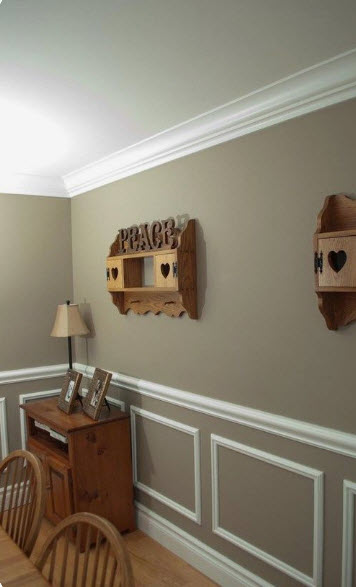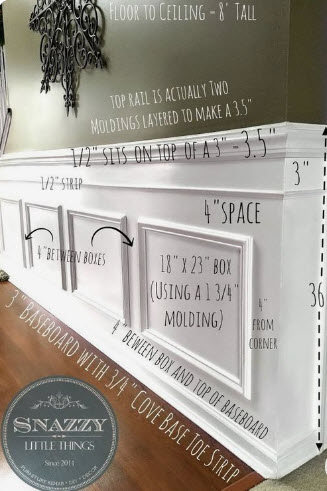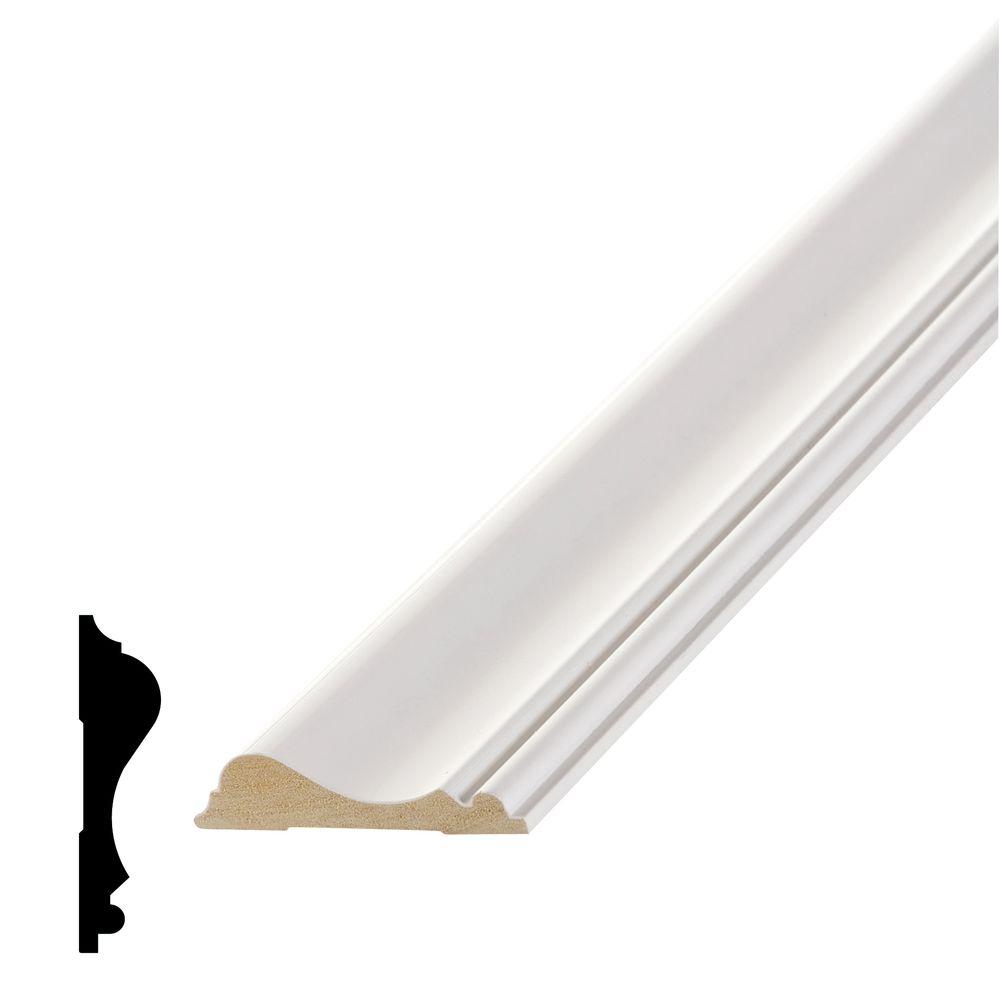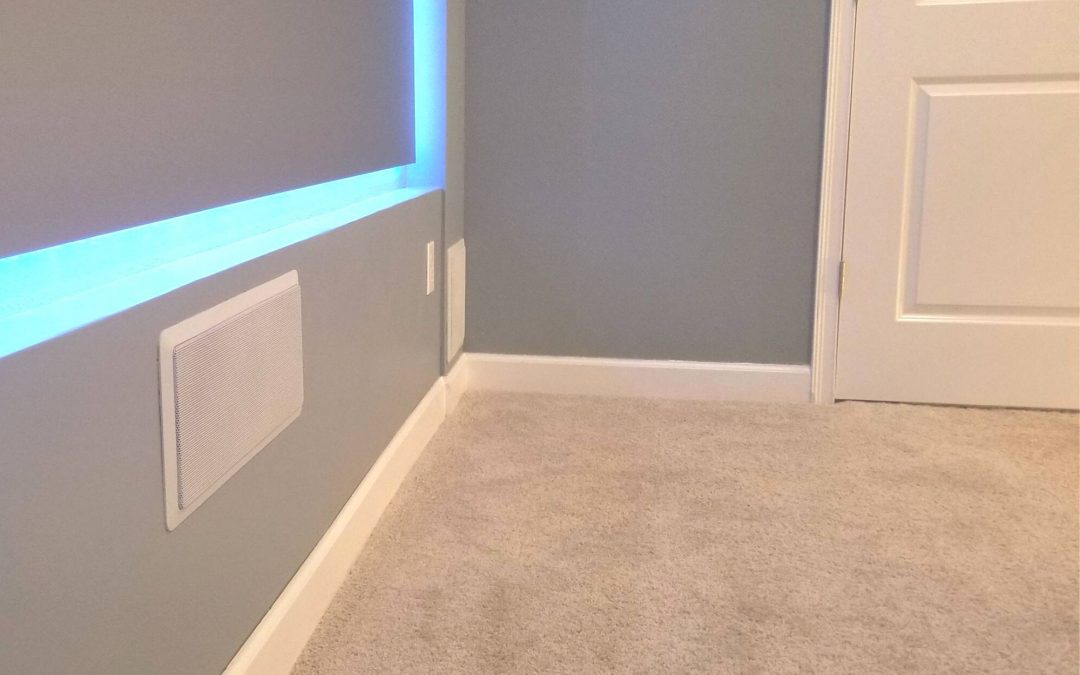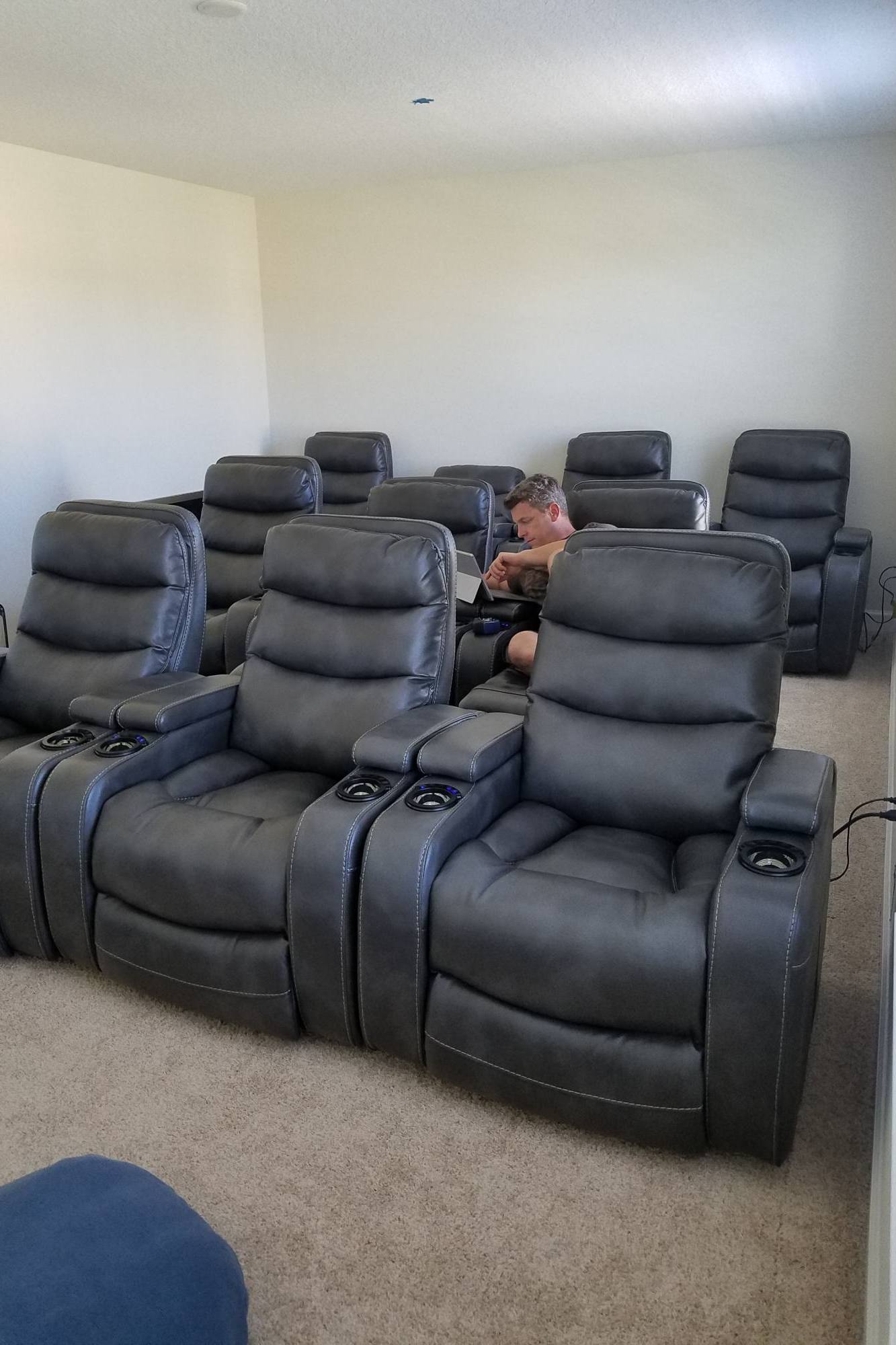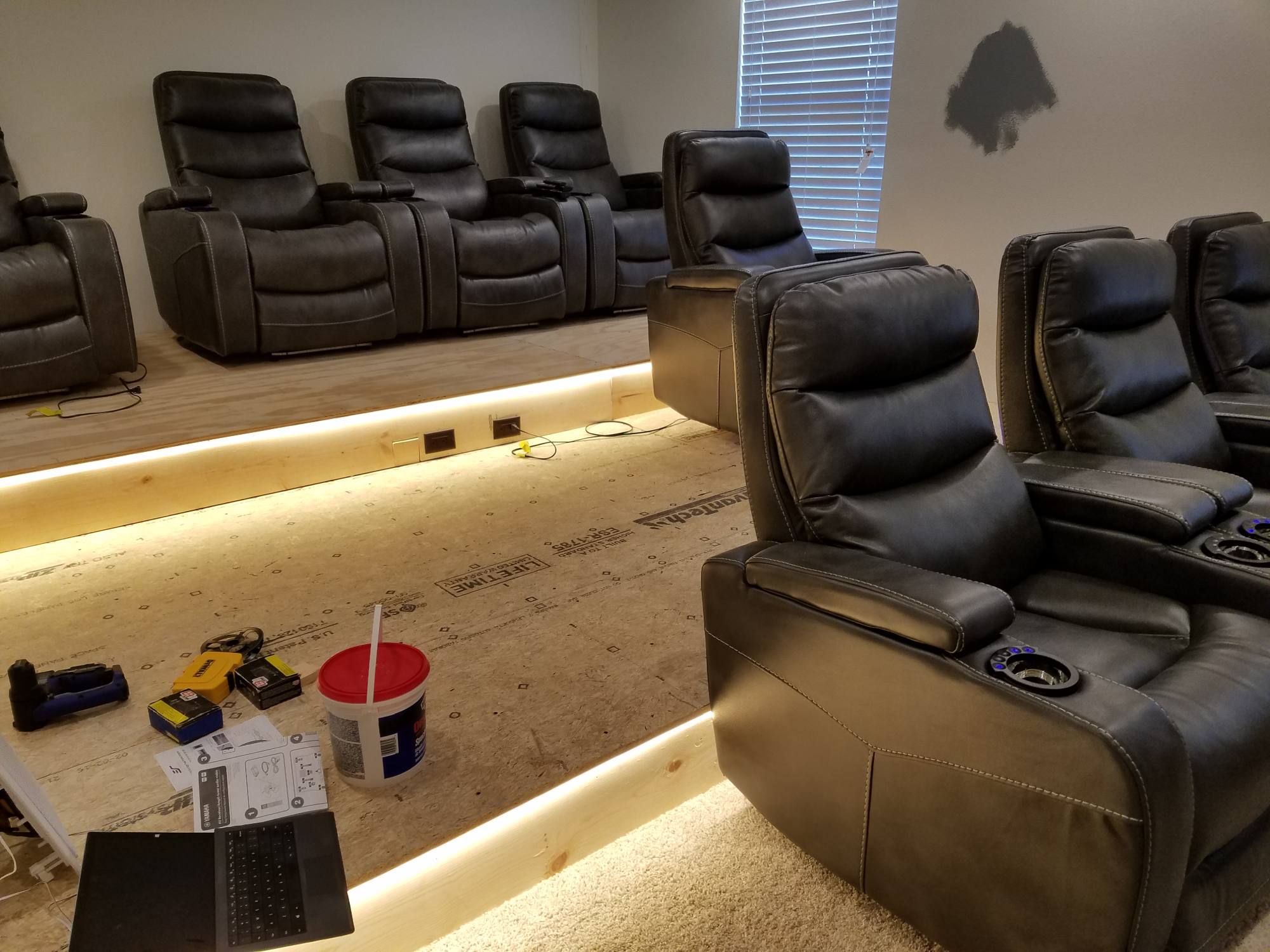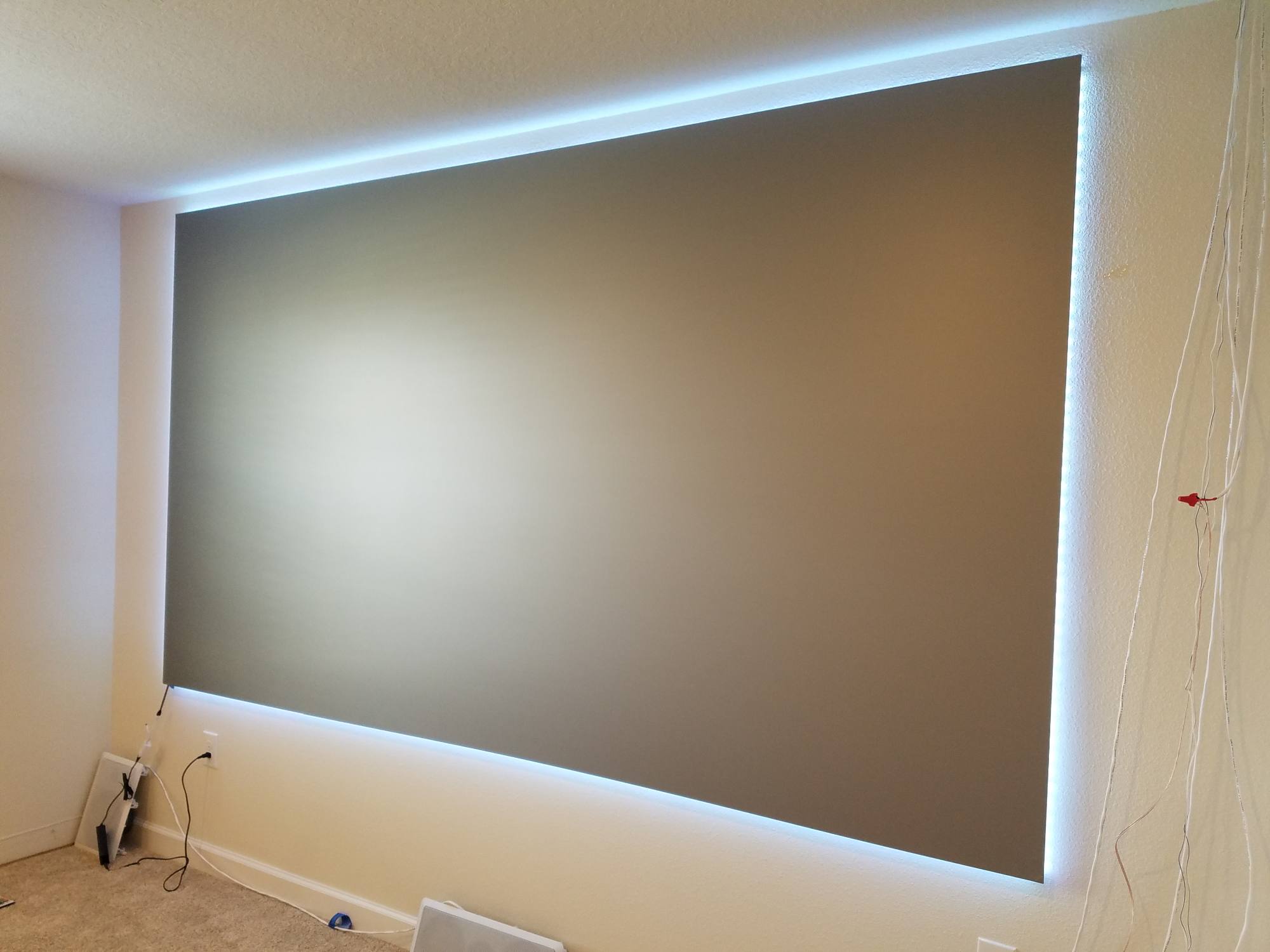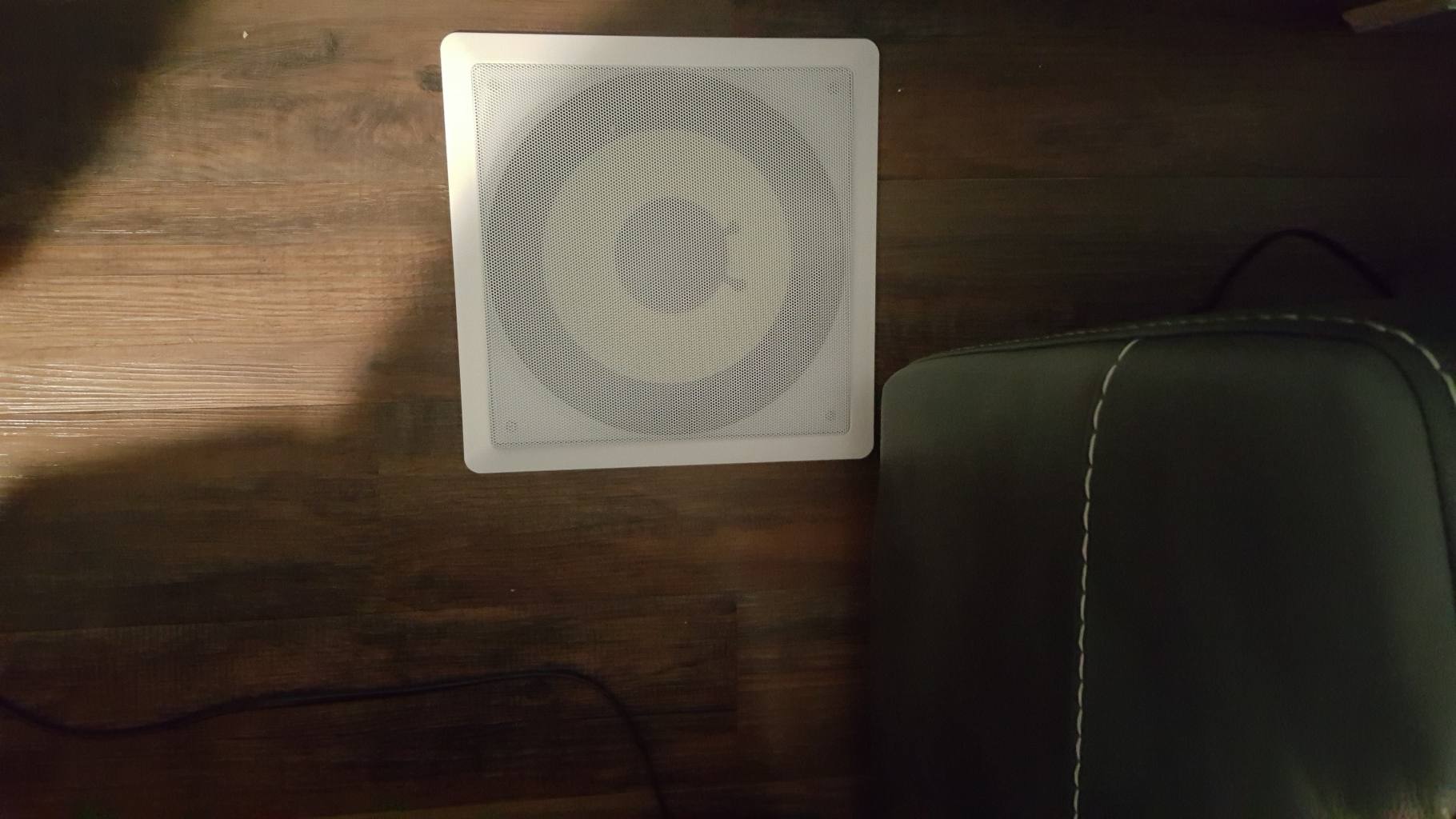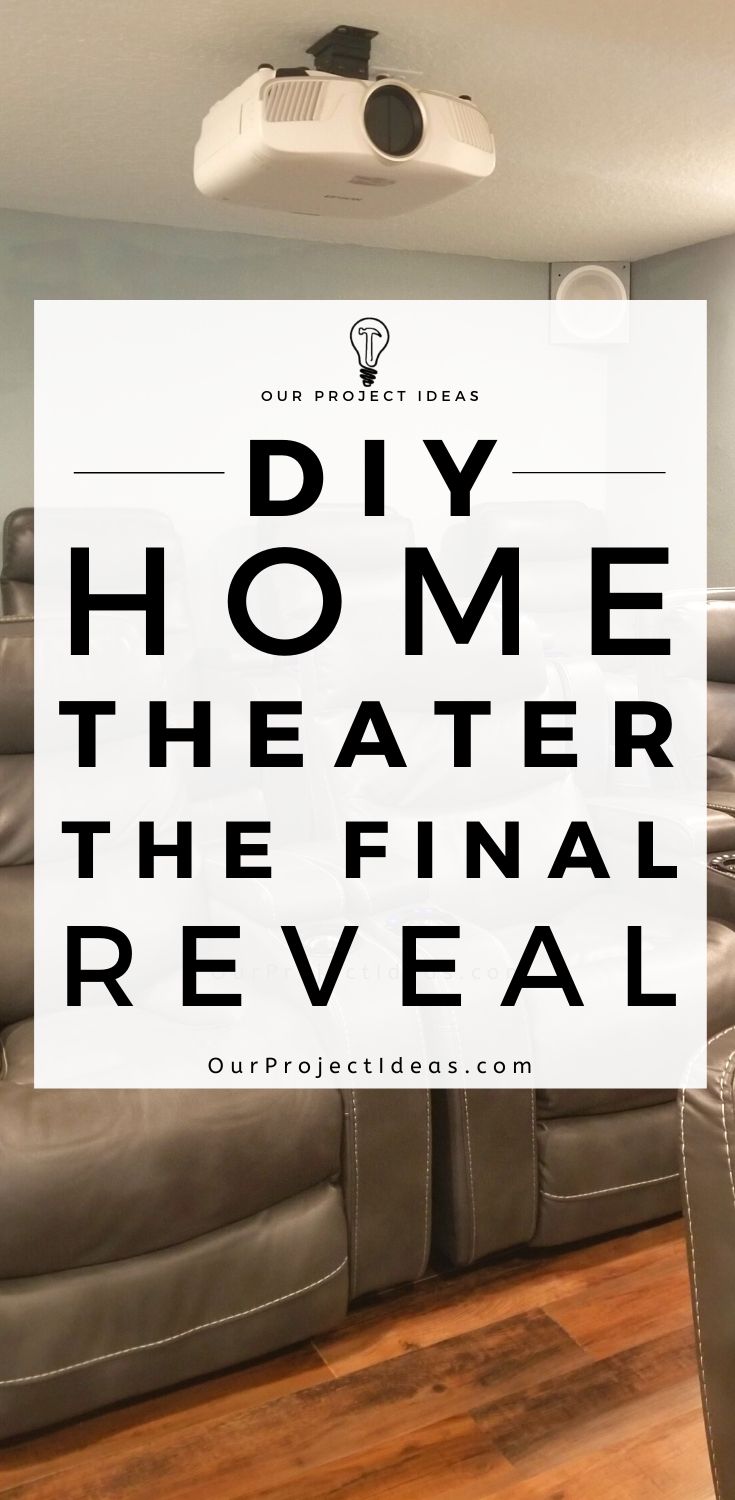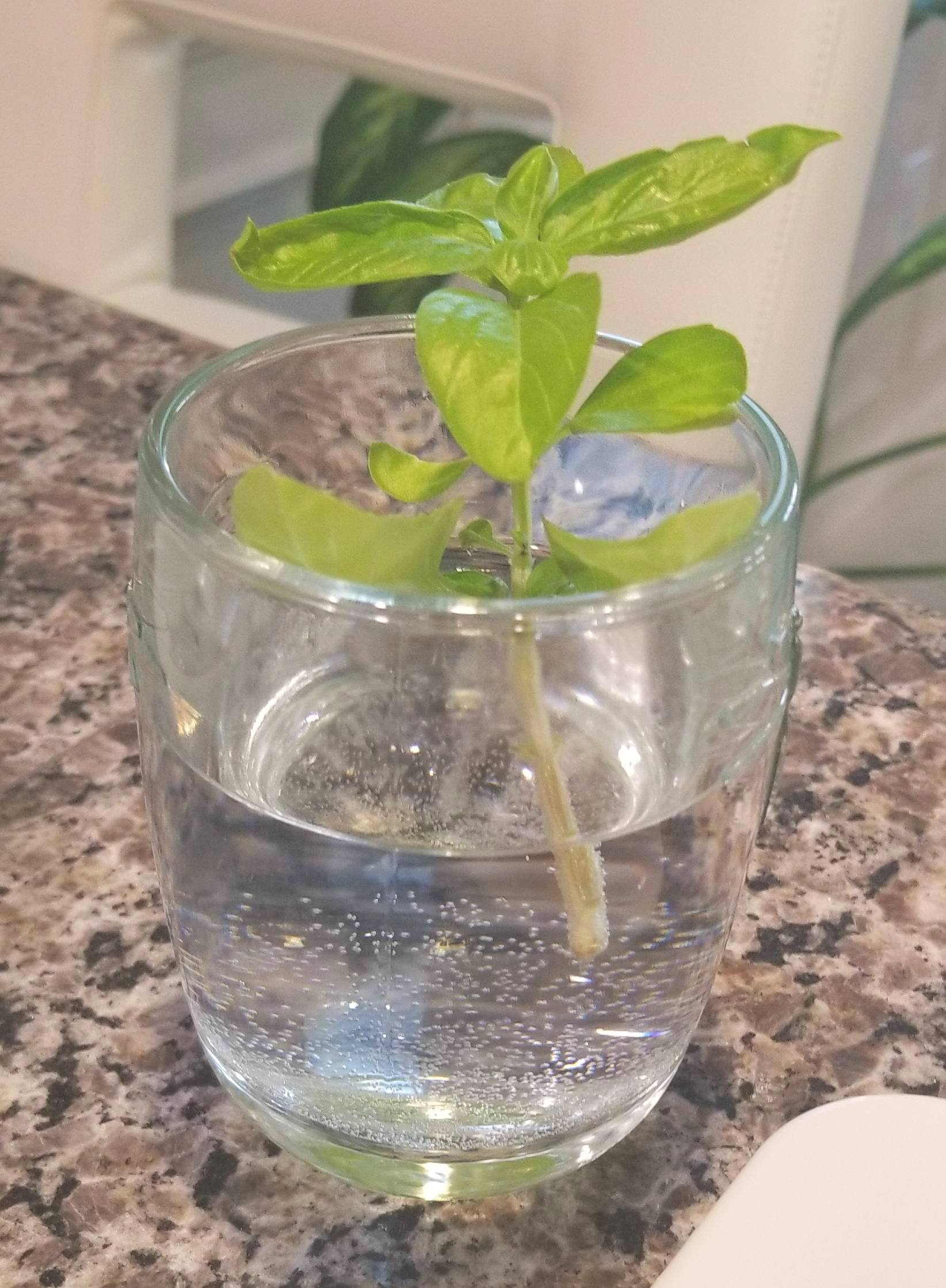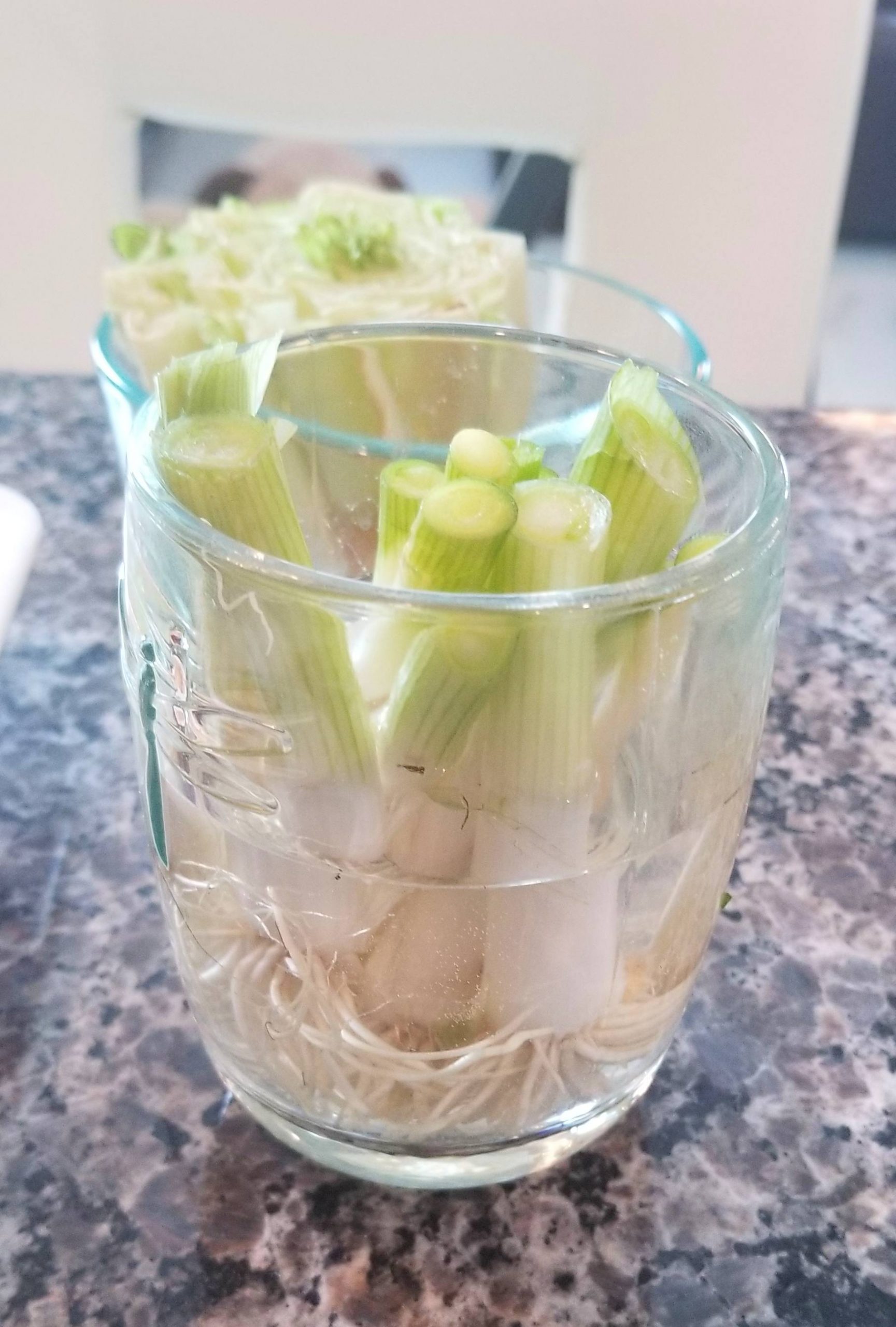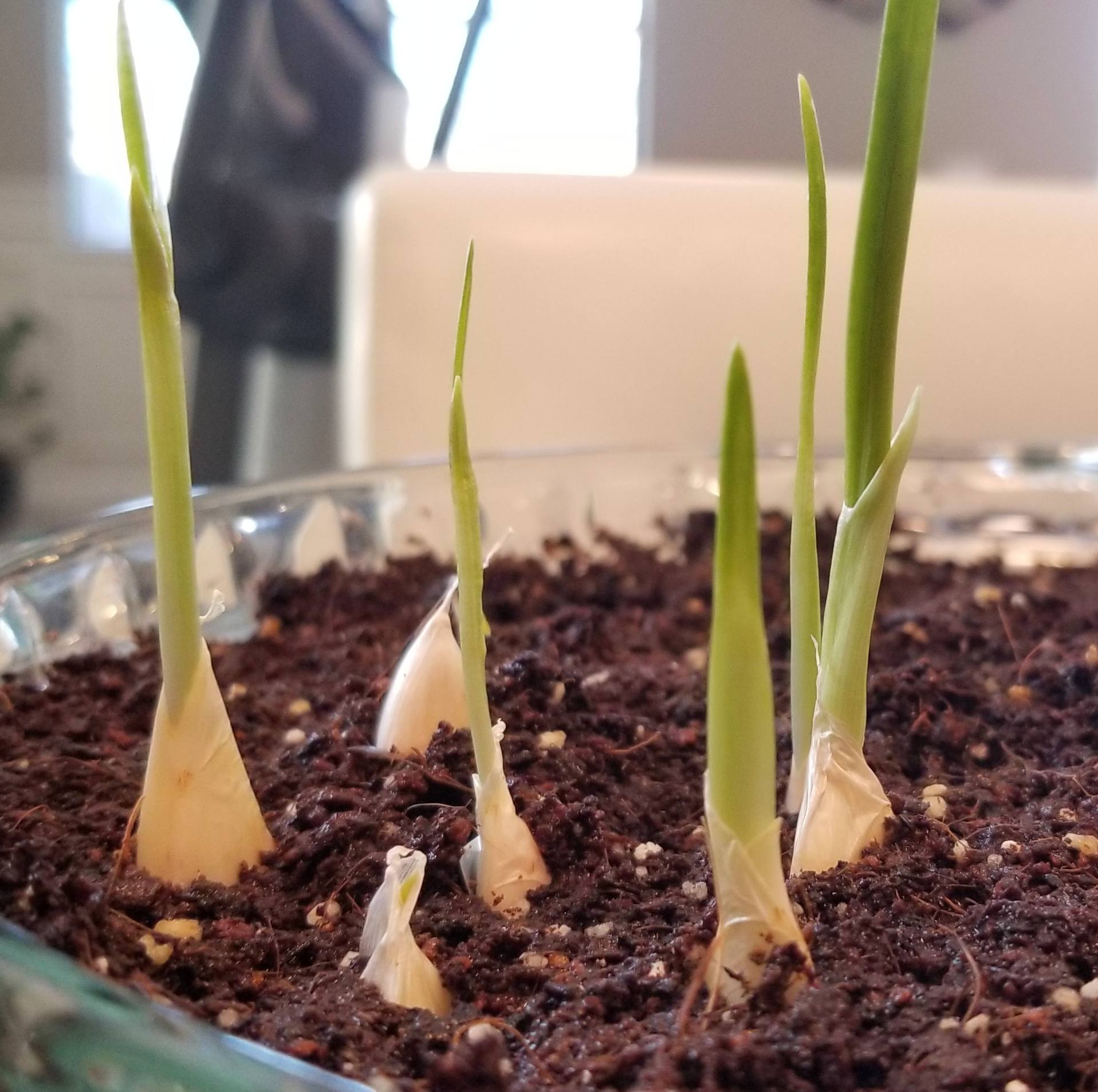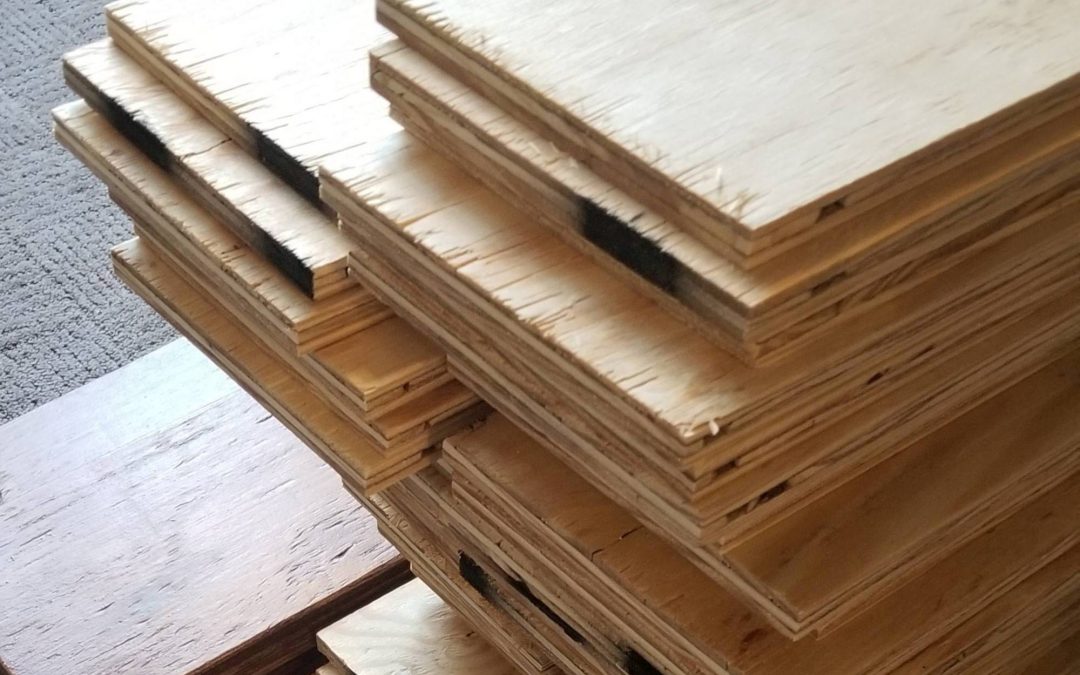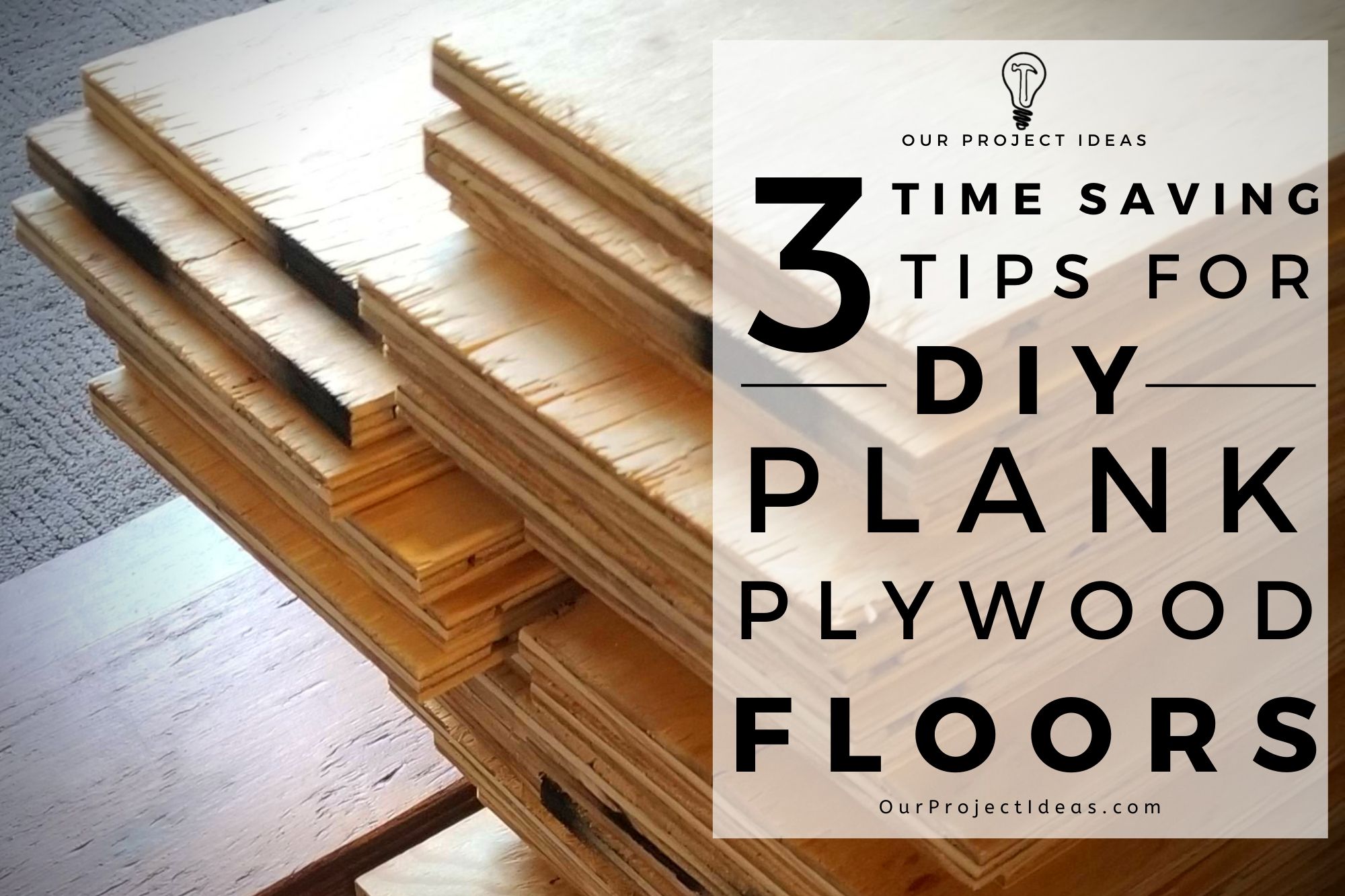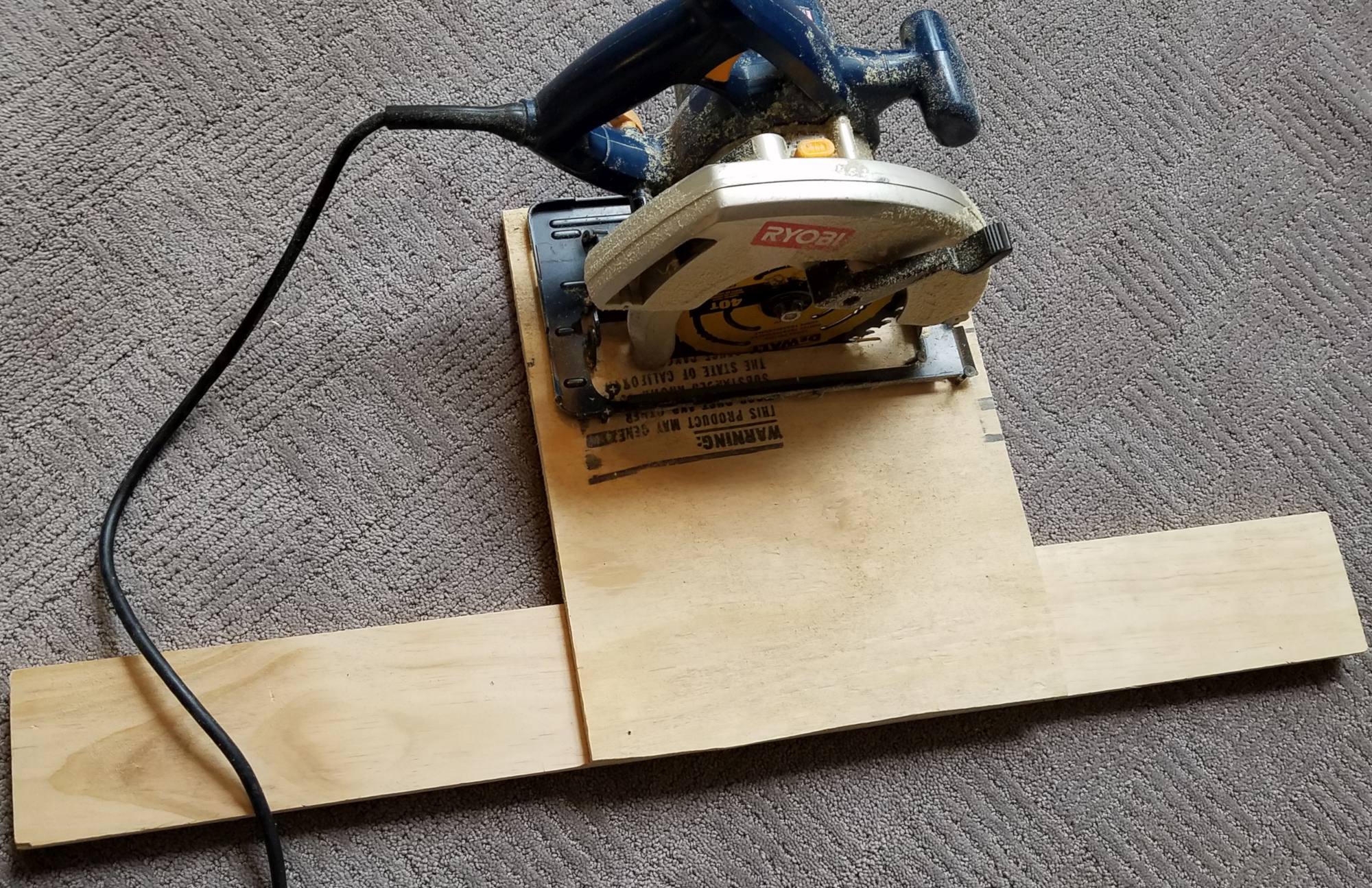
DIY Wainscoting – Deel 1 – Ontwerp en lay -out

Als je op Pinterest kijkt voor lambrisering, vind je allerlei verschillende stijlen en versies van lainscoting, Van de super simple tot de ongelooflijk sierlijke.
Ik wilde een lagcoterend ontwerp dat er chique uitzag zonder erover te gaan en ik wilde niet dat het te moeilijk was om te installeren.
Ik denk dat wat we hebben gekozen precies dat deed, Het heeft een heleboel stijl en karakter toegevoegd en ziet er geweldig uit. En het duurde niet veel tijd om te doen.
Ik deed eerst de lambrisering in de benedenverdieping, Toen besloot ik ongeveer een jaar later om ook bovenverdieping te doen. Als ik de tijd tussen de bovenverdieping en de benedenverdieping optelde, duurde het waarschijnlijk in totaal ongeveer 2 weken voor beide… Maar houd er rekening mee dat ze behoorlijk grote ruimtes zijn.
Het project wordt opgesplitst in een aantal berichten.
In dit bericht zullen we ons concentreren op het ontwerp dat we hebben gekozen en waarom we het hebben gekozen, Hoe we met onze lambriseringsgroottes kwamen, en hoe te meten voor lainscoting.
Dan zullen we in toekomstige berichten de lainscoting beperken, Het installeren van de lambrisering en ik denk dat ik er nog een zal doen op lambrisering in de trap, (spoiler alert, Er is meer wiskunde lol).
Het maakt niet uit welke stijl je kiest, U vindt hier tips om uw installatie soepeler te laten gaan.
Ik denk dat het geheim van het installeren van lainscoting het gebruik van sjablonen en spacers is. Aangezien de meeste stukken van de lambrisering dezelfde grootte zijn, kunt u sjablonen maken om ze sneller te snijden en de afstandhouders een consistente afstand mogelijk maken zonder elke ruimte te moeten meten.
Het gebruik van sjablonen en spacers met uw doe -het -zelfwinsten zal een enorme impact hebben op de lengte van uw installatietijd.
Openbaring: Sommige van de onderstaande links zijn gelieerde links. Als u besluit een van deze producten te kopen, We verdienen een kleine commissie zonder extra kosten voor u. We raden deze producten alleen aan omdat we er ervaring mee hebben en ze gebruiken voor onze eigen projecten. Als Amazon Associates, We verdienen aan kwalificerende aankopen.
Beslissen over een lainscoteringstijl
We keken naar veel Pinterest -pinnen van Wainscoting om er een te vinden die past bij de stijl die we in gedachten hadden.
Eerlijk gezegd, Als je niet weet welke stijl je wilt, Een zoekopdracht op Pinterest is een geweldige manier om erachter te komen welke keuzes je hebt.
Natuurlijk als je van de lambrisering lay -out en lijstwerk die we hebben gebruikt, Voel je vrij om te kopiëren wat we hebben gedaan. 🙂
DIY Wainscoting Ideas – Er zijn zoveel opties
Er zijn zoveel lagscotting -ideeën die er zijn, En ze zien er allemaal geweldig uit op hun eigen manier.
Neem een kijkje op de verschillende lay -outs die op Pinterest bestaan, Zoek uit en u zult talloze lainscotting -ontwerpen vinden. Als u niet precies vindt wat u wilt, Bedenk je eigen lainscoterende smaak die een mix is van een of twee ontwerpen die je leuk vindt.
Hier zijn er een paar Wainscoting Designs die we leuk vonden:
De pin de geïnspireerde ons
Dit is de pin die onze smaak van het legscoting -ontwerp inspireerde. We hielden van hoe het eruitzag en hield van de tweede horizontale vorming tussen de dozen of frames en de stoellijst.
Het lainscoteringsontwerp dat we hebben gebruikt
Onze smaak van lainscoting verschilt van de pin die deze op een paar manieren heeft geïnspireerd – Maar ik denk dat je de gelijkenis kunt zien.
De verschillen:
- Gebruikt een Heftier tweede horizontale vorm (Het is dezelfde die we hebben gebruikt voor de lambriseringsframes)
- Heeft de stoel hoger (Dus het stond in de rij met de keukenbar beneden en de halve muur boven)
- Gebruik rechthoeken die rechtop staan in plaats van de vierkanten of rechthoeken die liggen (Dat lijkt vrij gebruikelijk)
- Onze ruimtes rond de vierkanten zijn 3 1/2″ (De breedte van een stuk van 2×4)
De stijl
We keken naar veel Pinterest -pinnen van Wainscoting om er een te vinden die past bij de stijl die we in gedachten hadden.
We hielden van de Wainscoting -frames om meer rechthoekig te zijn dan vierkant en groter in plaats van breder.
Aanvankelijk, We zouden alleen de stoel bovenop de frames hebben, Maar nadat we het hadden geprobeerd, realiseerden we ons dat het iets extra iets nodig had, Dus we hebben nog een horizontale vorm toegevoegd tussen de stoelvorming en de frames.
De wschetsel Hoogte
Hoe hoog wil je dat je lainscoting gaat?
Ik kwam een bericht tegen dat de lainscoterende hoogte in detail bespreekt. Haar tip was om de regel van derden te gebruiken, wat betekent dat de lambrisering niet hoger moet gaan dan een derde van de muur.
Hier is de link Als je meer wilt weten.
Ik kwam het artikel niet tegen toen ik dit bericht begon te schrijven, Maar zelfs als ik het eerder was tegengekomen, Ik zou waarschijnlijk nog steeds niet de regel van derden hebben gevolgd. Dat komt omdat we voor elke verdieping wilden dat de lainscoterende hoogte in lijn zou komen met iets anders in de ruimte – En dat liet niet staan met een derde van de muurhoogte.
Op de eerste verdieping was het de keukenbar top en op de tweede verdieping was het de halve muur in de hokruimte.
Als u probeert een hoogte te bedenken om te gebruiken, Probeer de regel van derden, of let het uit met iets anders in de ruimte, of als er niet iets in de ruimte is waar je de lambrisering van wilt laten instellen, kun je de metingen gebruiken die we als uitgangspunt hebben gebruikt en aanpassen zoals je moet. 🙂
De hoogte (Van de vloer naar de bovenkant van de stoelstoel) Op de 1e verdieping was 41″ en de hoogte op de 2e verdieping was 41 1/2″.
Zoek de framebreedte uit
Dit was een van de grootste struikelblokken voor mij toen ik aan dit project begon. Hoe zou ik alle frames dezelfde breedte maken??
Omdat alle muren verschillende maten zijn het leek onmogelijk om ze allemaal dezelfde breedte te maken… En goed – het is.
Ik kwam er uiteindelijk achter dat elk lainscoterend frame niet dezelfde breedte of zelfs dezelfde hoogte hoeft te zijn. Het is in feite onmogelijk dat ze dezelfde breedte zijn, omdat de muurgroottes allemaal anders zullen zijn.
Ik wilde niet dat de frames vierkant waren als ik het kon vermijden en gebaseerd op de hoogte van de lambrisering die ik streefde naar frames die ongeveer 18 centimeter breed waren.
Ik heb een tool gemaakt die je kunt gebruiken om de breedte van de fotolijsten te berekenen, Bekijk het door op de onderstaande knop te klikken.
De lambriseringsafmetingen
Ik wilde dit benadrukken. De lagscoterende afmetingen zijn anders voor elke muur die u doet. De lainscoterende frame -afmetingen op dezelfde muur zullen hetzelfde zijn, Maar ze zullen anders zijn als ze op een nieuwe muur zijn, omdat de nieuwe muur meer een andere breedte zal zijn.
Dat komt omdat hoewel de framehoogte hetzelfde blijft, De lainscoterende frame -breedte zal veranderen op basis van de breedte van de muur en het aantal lambriseringsframes.
De ruimte rond de frames
De afstand tussen de frames is het ding dat consistent moet zijn. Houd de afstand hetzelfde en je hersenen zullen denken dat alle fotolijsten van dezelfde grootte zijn.
Zolang de afstand rond de frames hetzelfde is, zal alles stromen.
Voor de onze, We kozen een afstand van 3 1/2″ Overal rond elk frame, Op die manier kunnen we stukken van 2 gebruiken×4 als spacers. 😉
De wschetsel Metingen die we hebben gebruikt
De foto heeft alle lainscotmetingen die we hebben gebruikt.
Omdat elke muur een andere breedte heeft, de Wainscoting -afmetingen voor elke muur moeten anders zijn.
Alle afmetingen van De lainscoterende frames op dezelfde muur zijn hetzelfde.
Alle metingen op de foto blijven hetzelfde voor elke muur in de kamer, Behalve de wainscoterende frame -breedte (16 5/8″ op de foto) die zal veranderen op basis van de breedte van de muur en het aantal frames dat op de muur wordt gebruikt.
We wisten dat de totale hoogte van de lambrisering 41 1/2 was″ (om in de ruimte te staan met de hoogte van de halve muur in de ruimte) Dus we werkten achteruit van die meting.
We plaatsten de bovenkant van de stoel-molding op 41 1/2″ en plaatste de kleinere horizontale gieten eronder om te zien welke afstand daartussen en de stoel-molding voor ons werkte. We kwamen met 3″ (de dikte van ons niveau).
Omdat ik ook wist dat ik stukken van 2 x 4 zou gaan gebruiken als spacers, kon ik nu de hoogte van de Wainscot -frames achterhalen.
Hier is hoe we de hoogte van de Wainscot -frames hebben bedacht:
| De totale hoogte van de lambrisering | 41 1/2″ |
| Minus de stoelvorming dikte | – 2 3/4″ |
| Minus de ruimte onder de stoelvorming | – 3″ |
| Minus de tweede horizontale vormdikte | – 1 1/4″ |
| Minus de afstand boven het frame | – 3 1/2″ |
| Minus de afstand onder het frame | – 3 1/2″ |
| Minus de dikte van de plint | – 4 1/2″ |
| Is gelijk aan de lamsbot Kader Hoogte | = 23″ |
Het uitzoeken van de breedte van de lainscotting -frames
OK, Je hebt de stijl ontdekt, gieten, hoogte, afstand en de kleuren – Nu is het tijd voor wat wiskunde!
Dit deel kan een beetje intimiderend aanvoelen, maar geloof me, Het is veel gemakkelijker om te doen dan het lijkt.
Zoals elk ander aspect van dit project, Er zijn waarschijnlijk een miljoen andere manieren om dit uit te zoeken, maar hier is een voorbeeld van hoe ik het heb gemeten.
Laten we de muur op de afbeelding gebruiken voor het voorbeeld, De muur gemeten 124 1/2″ en ik gebruikte uiteindelijk 6 lainscoting frames.
Berekenen voor de 6 frames Getoond
Eerst, Ik trek de linkerafstand af van het totaal, Wat voor mij 3 1/2 is″ of 3.5″, Bekijk de foto voor meer visual.
Dat geeft me 121″, Deel nu 121″ Door het aantal frames waarvan u denkt dat het zou passen. In het afgebeelde voorbeeld heb ik 6 gebruikt.
121″ / 6 = 20.16″
Dus elk frame + het is een afstand aan de rechterkant zou gelijk zijn aan 20.16″ in breedte (De rode pijlen).
Dus de grootte van de frames zou 20,16 min de afstand rechts zijn.
De framegrootte zou nu 20.16 zijn – 3.5″ = 16.6″ (De blauwe pijlen)
Omdat ik een rechthoekige vorm wilde, 16.6″ Werkte goed. In principe, Ik probeer dezelfde formule met een extra frame of min een frame, En zoek degene die er het beste uitziet.
Laten we zeggen dat we voor 5 hebben berekend frames
Als ik het probeerde 5, het zou 121 zijn″ / 5 = 24.2 Dat betekent dat elk frame + de afstand op zijn rechts is 24.2″. Dus de framegrootte zou 24.2 zijn″ – 3.5″ (de afstandsgrootte) dat zou 20.7 zijn″
Het ding om in gedachten te houden is er geen goed of fout voor dit alles. Ik wilde dat mijn frames er in vorm meer rechthoekig uitzien dan vierkant en een breedte van 20.7″ zou vrij dicht bij de hoogte van 23 zijn″ Dus in plaats van 5 frames te doen, heb ik gekozen voor 6.
Decimaal omzetten in breuken
Dus nu weet je dat de frames 16.6 moeten zijn″… Hoe kom je er in de klus uit op een meetlint?!
Het uitzoeken van de cijfers was absoluut eenvoudiger met behulp van een rekenmachine, maar ik kwam een probleem tegen om het decimaal van de rekenmachine terug te zetten naar een breuk die ik met een meetlint kon gebruiken.
Het antwoord was destijds een widget die ik tegenkwam die decimalen omzet tot breuken die kunnen worden gebruikt met een meetlint. Het was niet 100% omdat soms de fractie die het me gaf 231/356 was… Dat helpt niet. lol
Nu, Ik heb een Wainscoting -calculator gemaakt. Geef het de metingen in breuken die u op een meetlint zou vinden en het bedenkt het lainscoterende frame met en geeft u de breedte in breuken die u op de meet meet meet mate. Geen wiskunde meer en niet meer 231/356! lol
Hoe om te gaan met Windows met Wainscoting
Dit is iets waar ik achteraf aan dacht. Als het venster onder de hoogte van uw lambrisering gaat, zou het het beste zijn om die muur in secties te meten, Met de ruimte onder het raam als zijn eigen gedeelte.
Ik heb wat lagcoterende foto's gezien waar ze een beetje gebruiken “L” Vormde frames om zich rond het raam te conformeren… Ik denk niet dat het er zo geweldig uitziet.
Ik denk dat het er meer in elkaar uitziet als de frames onder het raam een andere breedte en hoogte zijn – Zolang de afstand rond de frames hetzelfde is als de rest van de muur, past het allemaal in elkaar.
Ik had maar één venster dat mijn lay -out van de lambrisering beïnvloedde, En gelukkig was het gebeurd om dingen niet te veel te beïnvloeden. Toen ik het eenmaal had gedaan, realiseerde ik me dat het er beter uit zou hebben gezien als ik de muur in stukken had verdeeld en elk stuk behandelde als een aparte muur.
Neem een kijkje op de foto hieronder, Dat is het venster waar ik het over heb. Het ziet er niet slecht uit, Maar het was meer geluk dan wat dan ook. Ik ging van rechts naar links bij het installeren van mijn Wainscoting, Ik kwam bij het raam, besefte dat ik iets anders onder het raam moest doen (Merk op dat de twee vakken onder het raam niet zo breed zijn als die naast hen), Sleed het voor later en hervatte mijn fotolijsten aan de andere kant van het raam.
In plaats van, Ik had het moeten beter zijn geweest als ik de fotolijsten onder de raamlijn had met de vensterbreedte en de ruimtes aan elke zijde van het venster als afzonderlijke wanden behandelde en berekeningen voor elke kant afzonderlijk deed.
Ik heb de foto bewerkt om te laten zien hoe het eruit zou hebben gezien als ik de frames onder de raam line had met de randen van het venster. Excuseer de ruwe bewerking, Maar ik denk dat het wel een idee geeft van hoe het er beter uit zou hebben gezien.
Opnieuw, Het raam heeft het gelukkig niet te veel voor mij ingedrukt, Maar ik kan zien waar het echt lelijk kan worden als je niet van tevoren voor het venster plant.
Het vormen dat we gebruikten
We gebruikten twee verschillende stukjes vormen voor de lambrisering, De ene voor de stoel-molding en de andere voor de frames en de horizontale vorm tussen de stoelopname en frames.
We hebben ze allebei gekocht van Home Depot. Hier zijn ze, U kunt op de afbeelding klikken als u dezelfde vorm wilt krijgen.
De stoelstoelmolten (Bovenste vorm)
Dit is de stoelstoellijst. Er was een poly -versie van deze vorming die veel goedkoper is, maar de functies waren een beetje meer overdreven en we vonden het uiterlijk van de houtversie beter leuk.
Onze kleuren
Voor de muurkleuren hebben we greige kleuren gekozen (Een mix van grijs en beige).
Veel lagcoterende foto's die we tegenkwamen, lieten de lambriseringsframes wit op een andere gekleurde muur. Dat doet het lamsbeschermingsframe meer eruit, Maar we hebben ervoor gekozen om de frames in plaats daarvan dezelfde kleur te schilderen.
Het schilderen van de lambrisering dezelfde kleur als de muur geeft het een ingebouwde look, die we leuk vonden.
Als u dezelfde kleuren wilt gebruiken, zijn hier de twee kleuren die we hebben gebruikt:
Bodemverfkleur
Sherwin Williams
Esthetisch wit (SW7035)
Vitrage
Interieur satijn
Top verfkleur
Sherwin Williams
Opnieuw grijs (SW7030)
Vitrage
Interieur eierschaal
Dat is het voor de lambriseringsontwerp en lay -out
Dat is het voor het ontwerpen en opleggen van je lamsbeschiking -doe -het -zelf. Nu je al het nitty gruizig hebt ontdekt voor je lambrisering, is het tijd om wat golven te snijden! I’ll cover that in the next post!
Click on the button below to keep reading:
Some Pictures Of The Finished Wainscoting
Here’s some more pics of the wainscoting. I’m thinking of doing a post on the wainscoting in the stairs since that was a bit trickier. I haven’t used math like that since High school! lol
Let me know what you think, is there something you would have done different?
Share your thoughts in the comments below!
Enjoy this post? Pin it and share it with others!

